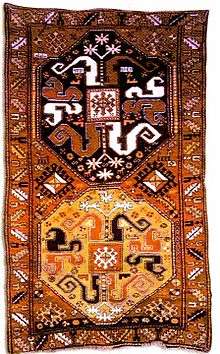Mesir macunu
| Mesir Macunu Festival | |
|---|---|
|
2010 Mesir Macunu Festival in Manisa, Turkey | |
| Country | Turkey |
| Reference | 642 |
| Region | Europe and North America |
| Inscription history | |
| Inscription | 2012 (7th session) |
Mesir Macunu is a traditional Turkish sweet believed to have therapeutic effects. Mesir paste was founded as a medicine during the Ottoman period but later on it became an important part of local festivity in the city of Manisa. Earlier versions of Mesir macunu were not sweet, but rather, were spicy in flavor.[1]
Macun is a sweet Turkish confectionery toffee paste that originated from spicy preparations of Mesir macunu.[1][2]
History
According to the story about the origins of Mesir paste; Ayşe Hafsa Sultan, who became the wife of Yavuz Sultan Selim and the mother of Suleyman the Magnificent after her placement from Crimea to the Ottoman Harem in the 16th century, became very ill after the death of her husband. Unfortunately doctors couldn't find a cure thus Sultan Suleyman consulted Merkez Muslihiddin Efendi, the head of the theological school belonging to the Yavuz Selim Mosque. He was already making medicines using herbs and spices for the sick people and built a small sort of hospital next to the school. After receiving Suleyman's letter regarding his ill mother, he mixed 41 different types of plants and spices together to form a medicinal paste and sent it to the palace. When Hafsa Sultan ate this paste, she was recovered and wanted to share this miraculous medicine with others. As requests from the people increased, the Sultan told Merkez Efendi to distribute the paste to the people every year in a form of festivity. For this, 22 March was selected because it symbolized the beginning of Spring, and the tops of the Sultan Mosque's domes and minarets were chosen for its location. The Mesir Celebration began this way in around 1527–28. Since then, every year on or around March 21, which is known as Spring festival Newroz, thousands of people gather in front of the Sultan Mosque to catch the Mesir Paste wrapped in paper and thrown from mosques rooftop. In 2009, due to the local municipality elections throughout the country, 469th Mesir Macun international Festival was postponed and held on April 26th. Meanwhile, in 2010 the 470th edition was held between March 21 – 28.
Herbs and spices used
Below is a list of spices and herbs used in making the Mesir Paste, along with their Turkish and Latin names:
- Allspice (Yeni bahar) (Pimenta dioica)
- Alpina officinarum root (Havlican koku) (Alpina officinarium)
- Anise (Anason) (Anisum vulgare)
- Black cumin (Corek otu) (Nigella sativa)
- Black Myrobalan (Kara halile) (Terminalia nigra)
- Black pepper (Karabiber) (Piper nigrum)
- Buckthorn (Topalak or Akdiken) (Nerprun alaterne)
- Cardamon (Kakule) (Elettaria cardamomum)
- Cassia (Hiyarsenbe) (Cassia)
- Chebulic myrobalan (Kara halile) (Terminalia chebula)
- China root (Cop-i cini) (Smilax china)
- Cinnamon (Tarcin) (Cinnamomum verum)
- Cloves (Karanfil) (Syzygium aromaticum)
- Coconut (Hindistan cevizi) (Cocos nucifera)
- Coriander (Kisnis) (Coriandum sativum)
- Cubeb (Kebabe) (Cubebae fructus)
- Cumin (Kimyon) (Cuminum cyminum)
- Dried orange blossom (Portakal cicegi)
- Fennel (Rezene) (Foeniculum vulgare)
- Galingale (Havlican) (Alpinia officinarum)
- Ginger (Zencefil) (Zingibar officinalis)
- Iksir sugar (Iksir sekeri)
- India blossom (Hindistan cicegi)
- Java Pepper (Kuyruklu biber) (Piper cubeba)
- Licorice extract (Meyan bali) (Glycyrrhiza uralensis fisch)
- Licorice root (Meyan koku) (Glycyrrhiza glabra)
- Mastic (Cam sakizi) (Mastichum)
- Millet (Hintdarisi) (Pennisetum glaucum)
- Myrrh (Murrusafi) (Commiphora Molmol)
- Muskroot (Sumbul) (Adoxa moschatellina)
- Mustard seed (Hardal tohumu) (Brassica nigra)
- Orange peel (Portakal kabugu)
- Rhubarb (Ravend) (Rheum Palmatum)
- Saffron (Safran) (Crocus Orientalis)
- Citric acid (Limon tuzu)
- Senna (Sinameki) (Cassia senna)
- Turmeric (Zerdecal) (Curcuma domestica)
- Udulkahr (Udulkahir)
- Vanilla (Vanilya) (Vanilla planifolia)
- Woad (Civit) (Isatis)
- Yellow myrobalan (Sari halile) (Fructus myrobalani)
See also
References
- 1 2 "The Turkish sweet tooth". DailySabah. November 24, 2014. Retrieved December 27, 2015.
- ↑ Isin, M. (2013). Sherbet and Spice: The Complete Story of Turkish Sweets and Desserts. I. B. Tauris. pp. 86–90. ISBN 978-1-84885-898-5.
